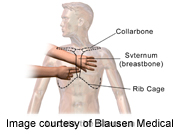
MONDAY, Dec. 10 (HealthDayNews) — Bystander CPR saves more lives when just chest compression is performed without mouth-to-mouth resuscitation, a new study from Japan shows.
Followed by use of easy-to-use publicly available defibrillators, chest compression alone kept more people alive with good brain function than traditional CPR (cardiopulmonary resuscitation) with mouth-to-mouth rescue breathing, the study found.
“We would like to suggest that compression-only CPR should be the standard and conventional CPR with rescue breathing the option,” said lead investigator Dr. Taku Iwami, a senior lecturer in the department of preventive services at Kyoto University School of Public Health.
When someone suffers cardiac arrest, the heart stops beating. Experts say the findings are welcome news because many people don’t want to perform mouth-to-mouth breathing or are unable to perform chest compressions and rescue breathing at the same time.
For the study, published Dec. 10 in the journal Circulation, Iwami’s team looked at the medical records of more than 1,300 people who suffered out-of-hospital cardiac arrests from 2005 to 2009.
In each case, the arrest was witnessed, and bystanders gave CPR and shocks from an automatic defibrillator (AED).
Almost 37 percent of the victims received only chest compressions, while the others got traditional CPR — chest compressions and rescue breathing.
In the month after their cardiac arrest, about 46 percent of those who received chest compressions alone were still alive, compared with about 40 percent of those who got traditional CPR, the researchers found.
Moreover, of those given chest compressions alone, more than 40 percent retained good brain function, compared with around 33 percent of those given compressions and rescue breathing, they added.
One expert supported the findings.
“This is very encouraging because it shows that simple actions like starting CPR with just chest compressions really made a positive difference and saved lives,” said Dr. Michael Sayre, a professor of emergency medicine at the University of Washington in Seattle.
Since 2008, the American Heart Association has recommended that when someone sees a person go into cardiac arrest, chest compression alone should be started. But Iwami said the matter was controversial, and the study was conducted to determine whether chest compression alone is effective.
Sayre said that if chest compressions are started almost immediately, there is enough air in the victim’s lungs to supply oxygen to the body.
Availability of an automated external defibrillator (AED) — a portable device that delivers an electric shock to restart the heart — is crucial to the patient’s survival, he said. AEDs are available in public areas in the United States and in other countries including Japan.
“It’s the combination that makes a big difference,” he said.
“Doing something is always better than doing nothing,” Sayre added. “So, if you see someone collapse, start pushing hard and fast on the center of their chest.”
Another expert, Dr. Gregg Fonarow, a professor of cardiology at the University of California, Los Angeles, noted that the majority of the people who suffered bystander-witnessed cardiac arrests during the study period did not receive any type of CPR or public access defibrillation.
That highlights “the critical need for global improvement in individuals trained and willing to perform chest compression-only CPR and increased access to automatic external defibrillator devices,” he said.
Iwami agreed. “We should implement programs to increase the number of lay rescuers who can at least perform chest compressions and use an AED,” he said.
However, in certain cases, traditional CPR is still preferable. For infants and children, for instance, the American Heart Association still recommends CPR with a combination of breaths and compressions.
Iwami said further studies are needed on whether bystanders should perform compression-only CPR on children.
More information
For more details on hands-only CPR, visit the American Heart Association.

